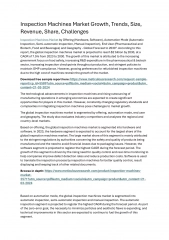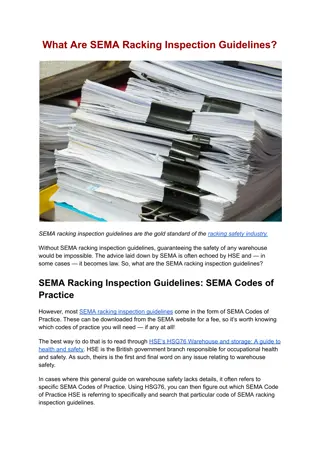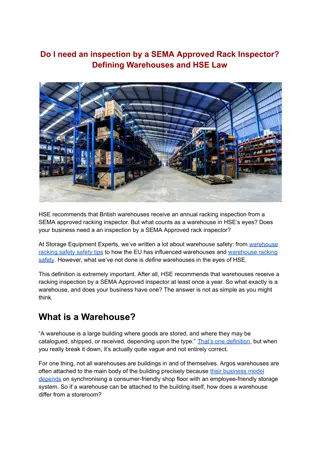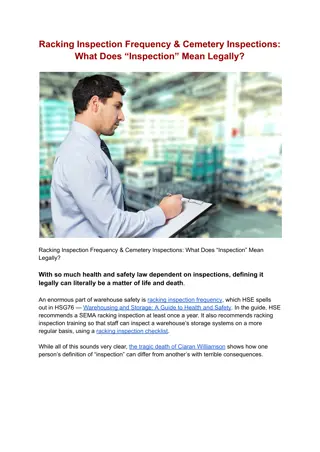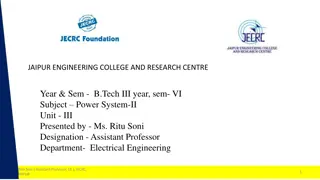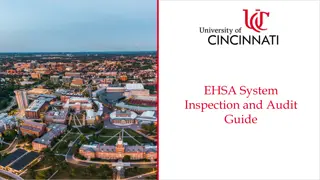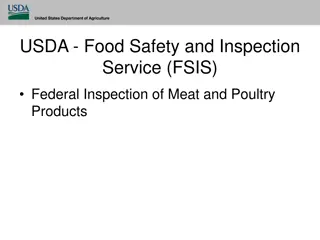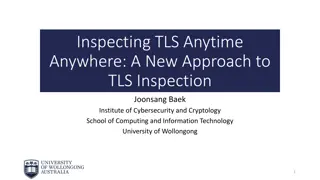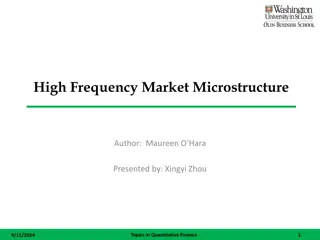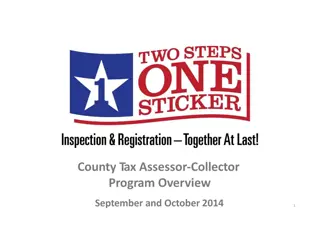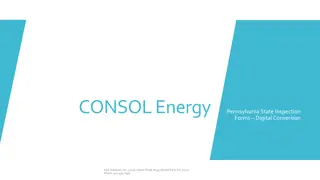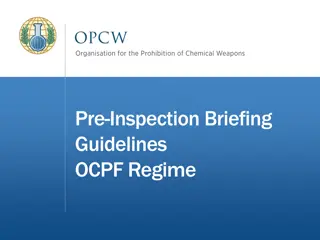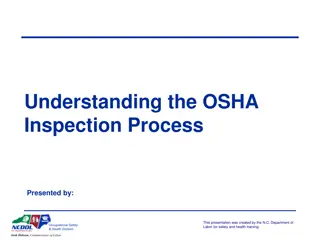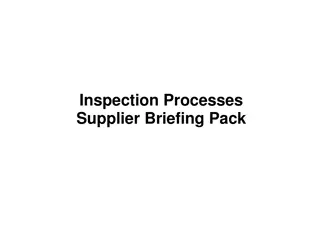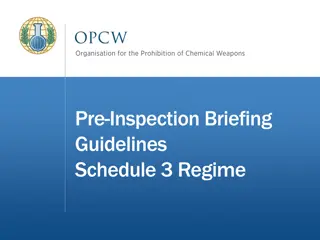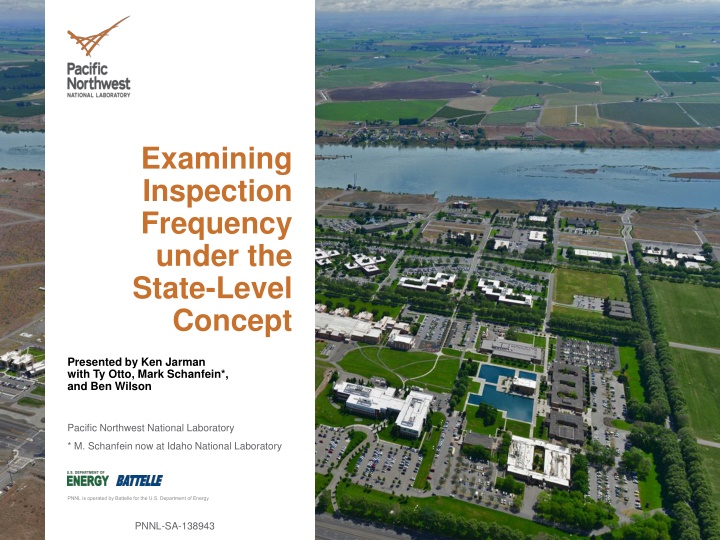
Examining Inspection Frequency Under State-Level Concept
This paper delves into the evolution of inspection frequency under the State-Level Concept (SLC) safeguards, emphasizing the need for a quantitative framework to enhance transparency, consistency, and eliminate unintentional bias in inspection plans. It discusses the importance of a mathematical approach to determine inspection frequency, linking technical objectives to verification activities. The idea of a Timeliness Goal Equation is explored to address the detection time window for early acquisition attempts, emphasizing the IAEA's role in deterring diversion and misuse through risk of early detection.
Download Presentation

Please find below an Image/Link to download the presentation.
The content on the website is provided AS IS for your information and personal use only. It may not be sold, licensed, or shared on other websites without obtaining consent from the author. If you encounter any issues during the download, it is possible that the publisher has removed the file from their server.
You are allowed to download the files provided on this website for personal or commercial use, subject to the condition that they are used lawfully. All files are the property of their respective owners.
The content on the website is provided AS IS for your information and personal use only. It may not be sold, licensed, or shared on other websites without obtaining consent from the author.
E N D
Presentation Transcript
Examining Inspection Frequency under the State-Level Concept Presented by Ken Jarman with Ty Otto, Mark Schanfein*, and Ben Wilson Pacific Northwest National Laboratory * M. Schanfein now at Idaho National Laboratory PNNL-SA-138943
Examining Inspection Frequency under the SLC Safeguards has evolved Acquisition paths State as a whole Declared facilities Criteria-driven accountancy Transparent formula but inspection plan decisions may be less transparent. A quantitative framework for inspection frequency could: Increase Member State confidence Enhance transparency, consistency Eliminate unintentional bias 2
A Need for a Quantitative Framework State-Level Concept Using APA and SSFs, analyzes acquisition paths and prioritizes technical objectives Objectives link what verification activities are performed with why they are performed The IAEA implements formal measures to ensure consistency and rigor, but: Publications provide no explicit info on inspection frequency, intensity adjustments to reflect knowledge of State s nuclear fuel cycle and other relevant factors. Is inspection frequency driven by expert judgment? Quantitative calculations? A mathematical/quantitative framework for inspection frequency e.g., a timeliness goal equation can be developed that: Provides needed clarity and consistency, and Does not return to mechanistic, criteria-based inspection resource allocation 3
Quantitative Framework Information Flow Plausible Paths (?) Time to completion (????) Technical objectives Ingredients for a Timeliness Goal Equation and inspection frequency APA State Evaluation Group Level of confidence in absence of undeclared activities (????????) SSFs Early-detection lead time (?????) Performance targets (???????) inspection intensity (not our focus) 4
An Idea for a Timeliness Goal Equation True time to complete an acquisition path ? (?????????,?) is unknown, may be among a range of times with different likelihoods a distribution ? ?????????,?= ??,? = 1, ,? Really want to know the detection time window (???????,?) within which an acquisition attempt must be detected IAEA mandate is to deter diversion and misuse through risk of early detection Accounting for a lead time hedges against uncertainty Derive a single value (avg., percentile, ?) to determine inspection frequency ? ?????,?= ??? ???????,?= ?? ?=1 5
An Idea for a Timeliness Goal Equation Special case: suppose either 1) State has not undertaken any undeclared activity on the acquisition path, so ???????,?= ????,? ?????,?, with probability ????????,?; or 2) State has all infrastructure on that path to convert material to weapon, so ???????,?= ????????,?, with probability 1 ????????,?. Then ?????,?= ????,? ?????,?????????,?+ ????????,?1 ????????,? for path ?. 6
An Idea for a Timeliness Goal Equation ?????,?= ????,? ?????,?????????,?+ ????????,?1 ????????,? This equation has several desirable properties: Where the agency has high confidence in the absence of undeclared activities (e.g., States with the BC), the goal is closer to estimated path completion time Where the agency lacks this confidence (e.g., States w/o an AP), the goal is closer to material conversion time For facilities with a very short time to path completion (e.g., industrial-scale enrichment or reprocessing), the timeliness goal will not be relaxed relative to historical baseline 7
Case Study #1: State with low technical capability Facilities and capabilities 4 LWR, 1000 Mwe Technical objectives Detect diversion of spent fuel Time to complete path 5 years Target lead time 6 months Worst-case time window 1 month Safeguards status CSA + AP only Probability of absence of undeclared activities50% CSA + AP + BC 90% TPu goal = (60 6 months)????????+ (1 months)(1 ????????) 8
Case Study #2: State with high technical capability 2 MTR (5 MWth and 35 MWth), 4 hot cells, 2 LWR (1000 MWe), 1 R&D GCEP, conversion, fuel fabrication, U mining Facilities and capabilities Technical objectives Detect diversion of fresh or spent fuel Time to complete path 6 months (HEU path); 12 months (Pu path) Target lead time 0.5 months Worst-case time window 3 months (HEU path); 1 month (Pu path) Safeguards status CSA + AP only Probability of absence of undeclared activities20% CSA + AP + BC 90% 9
Case Study #2: State with high technical capability THEU goal = (6 0.5 months)????????+ (3 months)(1 ????????) TPu goal = (12 0.5 months)????????+ (1 months)(1 ????????) 2 MTR (5 MWth and 35 MWth), 4 hot cells, 2 LWR (1000 MWe), 1 R&D GCEP, conversion, fuel fabrication, U mining Facilities and capabilities Technical objectives Detect diversion of fresh or spent fuel Time to complete path 6 months (HEU path); 12 months (Pu path) Target lead time 0.5 months Worst-case time window 3 months (HEU path); 1 month (Pu path) Safeguards status CSA + AP only Probability of absence of undeclared activities20% CSA + AP + BC 90% ~5 months (HEU); ~10 months (Pu) Calculated timeliness goal ~3 months 10
Conclusions A quantitative framework for inspection frequency is possible, but faces many challenges that could be addressed with additional study A timeliness-goal equation is a step in a useful direction, not the final answer Calculated timeliness goal is a guide, not a criterion Helps make assumptions behind decisions more explicit and transparent for SEG consideration Provides SEGs with a starting point that they can modify based on all available safeguards-relevant information Provides a common framework for consistency across States Can be used to highlight the extent to which in-field verification plans are sensitive to assumptions about the effectiveness of certain safeguards activities 11
Acknowledgments Research for this paper was funded by the U.S. Department of Energy s National Nuclear Security Administration Project Team Ken Jarman, math/statistics for nonproliferation Ty Otto, nonproliferation policy Ben Wilson, safeguards/analysis Mark Schanfein, nonproliferation advisor 12
Some Challenges to a Timeliness Goal Equation 1. Difficult to estimate input parameters (????????, time windows, etc.) SEGs cannot be expected to quantify these Parameters are highly uncertain Solution: Adapt expert elicitation and structured probabilistic methods used in other fields (e.g., nuclear safety, public policy analysis) 2. Multiple overlapping paths and objectives Solution: Expand the timeliness-goal model to a path-level probabilistic model, combining objectives and incorporating estimates of detection probabilities over time1 3. Must be able to evaluate inspection plan effectiveness Solution: Build on the expanded path-level model, combining detection probability over time across paths2 1 See Anzelon et al. in Proc. INMM Annual Meeting (2016) 2 See Budlong Sylvester et al. in Nuclear Safeguards, Security, and Nonproliferation (2008) 13
Thank you 14
Historical Perspective Inspection frequency: the frequency with which inspectors visit a declared facility (e.g., annual PIV, monthly IIV, less frequent SNRI) Prior to AP and Integrated Safeguards: the Safeguards Criteria Material type and amount, facility formula for frequency (e.g., detect diversion of 1 SQ LEUF6 at GCEP monthly inspection) Simple, non-discriminatory No flexibility for using SG-relevant info to guide inspection resource allocation Integrated Safeguards and the Broader Conclusion Allowed for less frequent inspection at declared facilities (e.g., timeliness goal for spent fuel at reactors increased from 3 months to 1 year) State-Level Concept Using APA and SSFs, analyzes acquisition paths and prioritizes technical objectives Objectives link what verification activities are performed with why 15
Quantitative Framework Requirements Inspection frequency determination should: Address the need for timely detection of diversion or misuse along plausible acquisition paths Be transparent, objective, technically defensible, technically achievable Be consistent with the practices embodied in the SLC, especially: Use of APA and supporting SG-relevant info to identify, prioritize objectives Reliance on the 6 SSFs for differentiation among States A focus on achieving technical and generic objectives (not mechanistic criteria) 16

